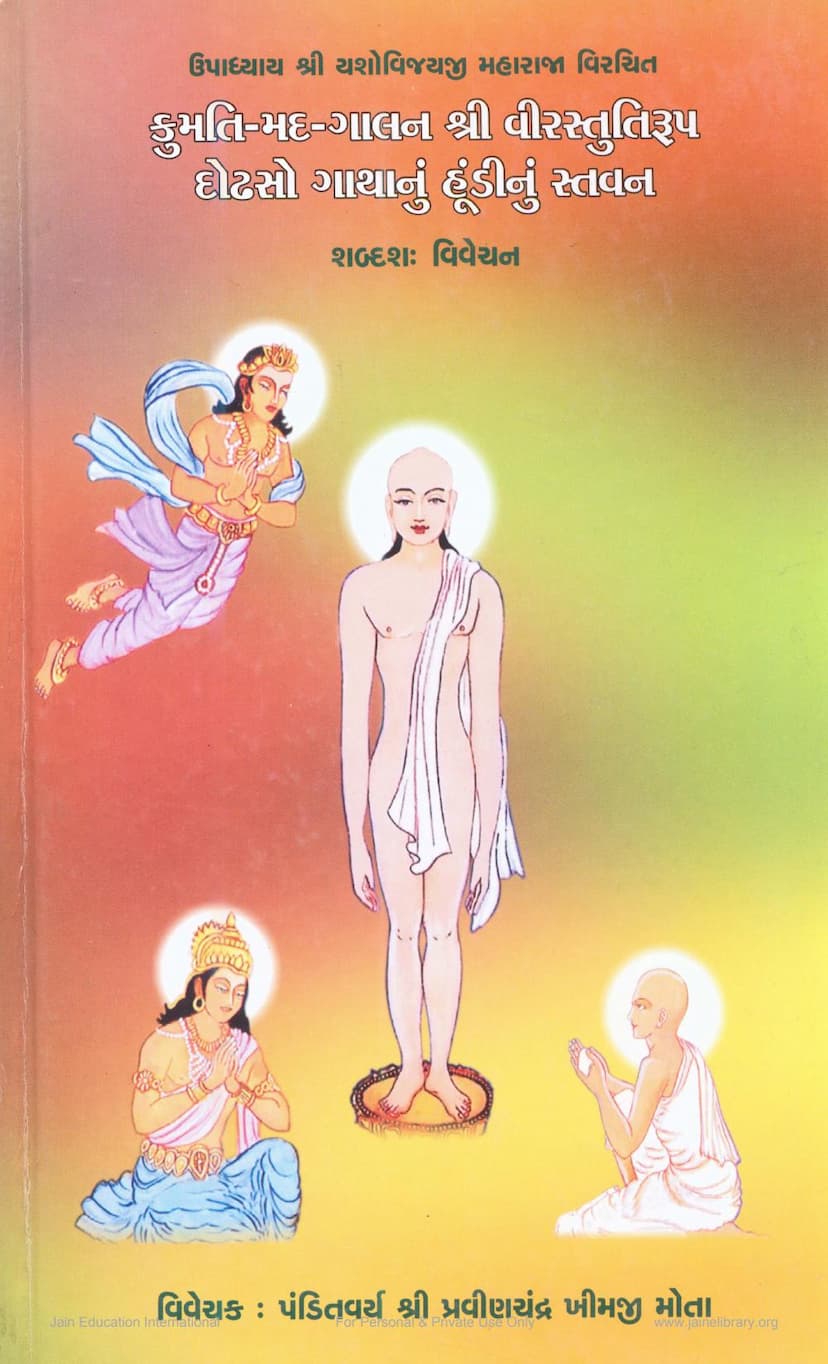Kumatimadgalan Veer Stutirup 150 Gathanu Hundinu Stavan
Added to library: September 2, 2025

Summary
This document is a commentary (vivechan) in Gujarati by Pandit Pravinchandra Khimji Mota on the "Kumati-mad-gaalan Shri Veer Stutirup 150 Gathanu Hundinu Stavan" (A hymn of 150 verses in the form of a 'Hundi' devoted to Lord Mahavir, which dispels evil intellect and pride), originally composed by Upadhyay Shri Yashovijayji Maharaja.
Here's a comprehensive summary of the key points and themes discussed in the commentary, organized by the structure of the text provided:
Overall Purpose:
The commentary aims to provide a detailed, verse-by-verse explanation of Yashovijayji's hymn praising Lord Mahavir. The hymn itself is designed to counter negative intellect and pride, specifically addressing the views of the Sthanakvasi sect regarding the worship of Jain idols. The commentary meticulously argues for the validity and significance of idol worship within the broader framework of Jain philosophy.
Key Arguments and Themes:
-
The Purity of the Lord's Teachings and the Importance of Faith:
- The introduction emphasizes that the pure exposition of Lord's teachings is the cause of liberation.
- The commentary strongly advocates for accepting Sthapan Niskhep (the principle of establishing an idol or symbol to represent the true essence) as a valid means of worship, supported by various scriptural injunctions.
-
Scriptural Support for Idol Worship:
- The commentary extensively cites scriptures like Anuyogdwar Sutra, Sthananga Sutra, Aavashyak Sutra, Arhant Cheiyarn Sutra, Bhagvati Sutra, Samavayan Sutra, Dashvaikalik Sutra, and Raypaseni Sutra to establish the venerability of Jain idols.
- It interprets verses from these texts to demonstrate that even powerful beings like celestial beings (Suryaabhdeva, Janghacharana Muni, Vidyacharana Muni) and revered figures like Bharat Chakravarti and Draupadi engaged in acts of worship towards idols or representations of the divine.
- The commentary emphasizes that the term "Chaitya" in scriptures refers to idols, not just abstract knowledge, and that the worship of these idols leads to auspiciousness and spiritual progress.
-
Refutation of Sthanakvasi Views:
- A significant portion of the commentary is dedicated to refuting the Sthanakvasi belief that idol worship is flawed due to the Ārambh (involvement of living beings, specifically the six-sensed) involved in it.
- The author argues that when worship is performed with proper Yatana (carefulness) and Bhakti (devotion), the inherent Ārambh in the ritualistic actions does not lead to karmic bondage. Instead, it fosters auspicious mental states and contributes to spiritual merit.
- The commentary clarifies that the perceived 'himsa' (violence) in idol worship is merely an upachara (a symbolic representation or ritualistic act) and not a true himsa that binds karma.
-
The Nature of Niskhepas (Categories of Representation):
- The commentary delves into the concept of the four Niskhepas (Name, Sthapana, Dravya, Bhava) as expounded in Jain scriptures, arguing that Sthapana Niskhep (the principle of establishing a symbol) is a valid and revered category, thus validating idol worship.
-
The Efficacy of Idol Worship:
- The text asserts that idol worship, when performed with proper understanding and devotion, is not merely an external ritual but a means to cultivate inner devotion, recall the virtues of the Tirthankaras, and ultimately leads to spiritual progress.
- It highlights how the devotion towards idols can inspire good qualities and lead to favorable rebirths and spiritual attainment.
-
The Role of Faith and Understanding:
- The commentary stresses that the true efficacy of idol worship lies not just in the act itself but in the understanding and faith of the devotee.
- It criticizes those who misinterpret scriptures to deny the validity of idol worship, labeling them as ignorant (ajñāni) or misguided (kumati).
-
The Importance of the Pānchāṅgī (Five Limbs of Jain Literature):
- The commentary emphasizes the authority of the Pānchāṅgī (Sutra, Niryukti, Bhashya, Tika, Churni) in interpreting Jain scriptures and validating religious practices. It argues that rejecting the Pānchāṅgī is equivalent to rejecting the Lord's teachings.
-
The True Meaning of Scriptures and the Guru's Role:
- The author stresses the importance of understanding the literal meaning of scriptures and the guidance of a qualified Guru (Gitārtha Guru) for proper interpretation.
- It highlights that scriptures often use symbolic language and that a correct understanding requires proper context and adherence to traditional interpretations.
-
The Nature of Ārambh and Yatana:
- The commentary differentiates between harmful Ārambh (involvement in violence) and Yatana (carefulness and diligent practice) performed with devotion. It argues that rituals performed with Yatana do not incur karmic sin.
-
The Commentary's Structure and Goal:
- The commentary is presented in a systematic manner, explaining each verse and its deeper meaning.
- The ultimate goal of the commentary is to provide a clear and scripturally-supported understanding of the hymn and, by extension, to reinforce the legitimacy of idol worship within the Jain tradition.
In essence, the commentary is a robust defense and detailed exposition of a devotional hymn that reaffirms the significance of idol worship in Jainism, supported by extensive scriptural references and a critical engagement with opposing viewpoints.